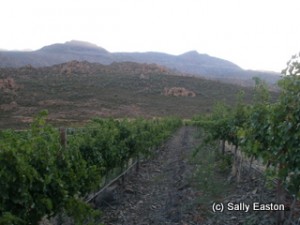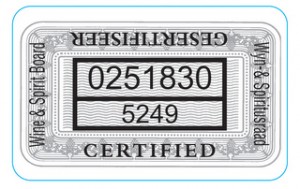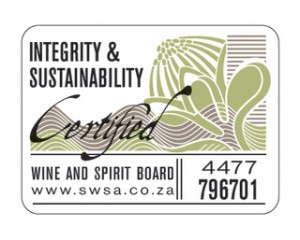Sustainability seal for South Africa
For anyone interested in sustainability issues, the South African wine industry is littered with meaningful acronyms, which can be a real struggle to get one’s head around, and which are explained below. There’s another new one, coming into effect with the 2010 vintage, which they hope will shine as a beacon for increasingly sustainable wine making practices.

Vines and veldt
The key initiatives, in terms of moving a little further along the path of sustainability, are the IPW (Integrated Production of Wine) and BWI (Biodiversity and Wine Initiative). The new one – SWSA (Sustainable Wine South Africa) – allies these two and links into the authority that governs and approves South African wine – the Wine Standards Board.
The Board is responsible for the wine of origin scheme, which confirms the vintage, variety and South African origin of the wine. A seal is printed on every bottle of South African wine that conforms to the wine of origin scheme.
From the 2010 vintage the Board will also confirm which wines have been made by certified IPW producers. A new, ‘sustainability’ seal exists to show conformance to IPW. To qualify for the new seal every part of the production process must be IPW accredited – the farm/vineyard, the winery and the bottling plant. The new sustainability seal is only available to wines bottled in South Africa.

Wine of origin seal
Any wines not made to the certified IPW standards will continue to use the wine of origin seal.
Su Birch, the CEO of Wines of South Africa, the organisation that promotes South African wine in export markets, said SWSA took its inspiration from ‘hannuwa’, the “heritage of the bushmen, who gathered good fortune by living in harmony with nature, and by not harvesting more than nature could replenish each year.”
Birch added “we believe 50% of wines will go out with this seal in 2010, and over 80% by the 2011 vintage.” The aim, she added of the voluntary scheme, “is to make it compulsory.”
The industry-wide IPW scheme has been running since 1998. It is similar to integrated farm management schemes that exist in Europe, in that it aims to reduce industrial inputs into the farming (in this case vine growing) system, reduce carbon emissions and introduce a more integrated approach to pest management, health and safety of workers, conservation of biodiversity, and treatment of waste water. The scheme requires accurate record keeping of actions in the vineyards.

Sustainability seal
The compliance of these records is now being independently audited every three years by a third party. Given that this scheme has been running for 12 years, Birch said “producers are finding a reduction in input costs as natural predators return.” And, she said, most of the industry already complies with IPW.
As more information on sustainability comes into the knowledge sphere, “IPW is constantly evolving with new elements introduced” said Jo Wehring, the UK market manager of Wines of South Africa, adding “so it never really stands still. Measuring and reporting on carbon will be introduced in the next stage, then we can look at how to reduce it. And the ‘pass’ mark is increasing, in 2008 a pass was 55%, in 2009 it was 60% and this year it’s 65%.”
Whilst there are some biodiversity guidelines in the IPW accreditation, producers can achieve IPW conformance – and get the new sustainability seal – without being part of the biodiversity and wine initiative. This separate BWI scheme, which has operated since 2004, exists for more comprehensive biodiversity and conservation in the Cape winelands.
This is particularly important in South Africa because the Cape Floral Kingdom, a biodiversity hotspot, is the smallest and richest plant kingdom on the planet, achieving World Heritage Site recognition in 2004. It accounts for just 0.5% of the area of Africa yet is home to 20% of the continent’s flora. And this region is where virtually all of South Africa’s wine production originates, so linking the two makes good sense, especially as 80% of the Cape Floral Kingdom is privately owned.

BWI - bottom left
Birch said the BWI “came about because we grow our wine in a special environment.” The aim here is to put aside land within the Cape winelands for conservation and reversion to indigenous flora.
The BWI already has 113,000 hectares under conservation status on wine farms. There are 101,000 hectares of vineyard in South Africa, so this is a better than 1:1 ratio. The top tier of BWI members, fifteen BWI champions, including Paul Cluver, Delheim, Oak Valley and Vergelegen, have committed more than 10% of their farms to conservation.
As well as the new sustainability seal, individual producer labels may have details of their BWI status as well, so checking wine bottles closely will reveal degrees of increasing sustainability.
Comments
2 Responses to “Sustainability seal for South Africa”




July 18, 2010 at 9:38 am
This is fantastic – South Africa has had this coming for a while and finally WOSA has made serious moves to involving everyone. Just another reason why SA makes great wine and is the best place to be!
August 11, 2010 at 9:09 pm
Good job on the article, the world needs more info on SA wines.
I have worked in NYC wine shops for many years and most customers are not aware of SA wines.